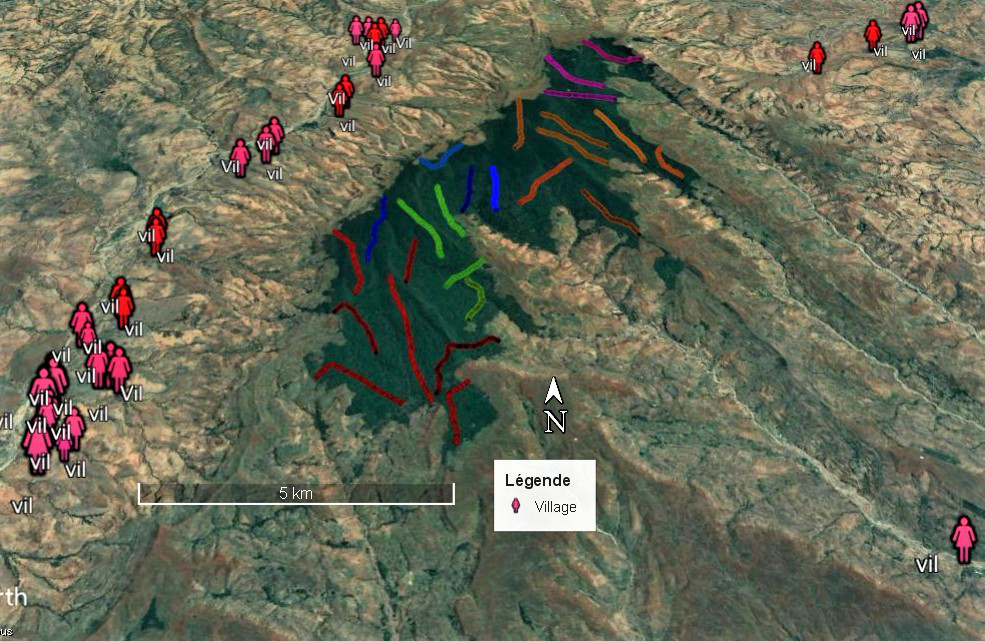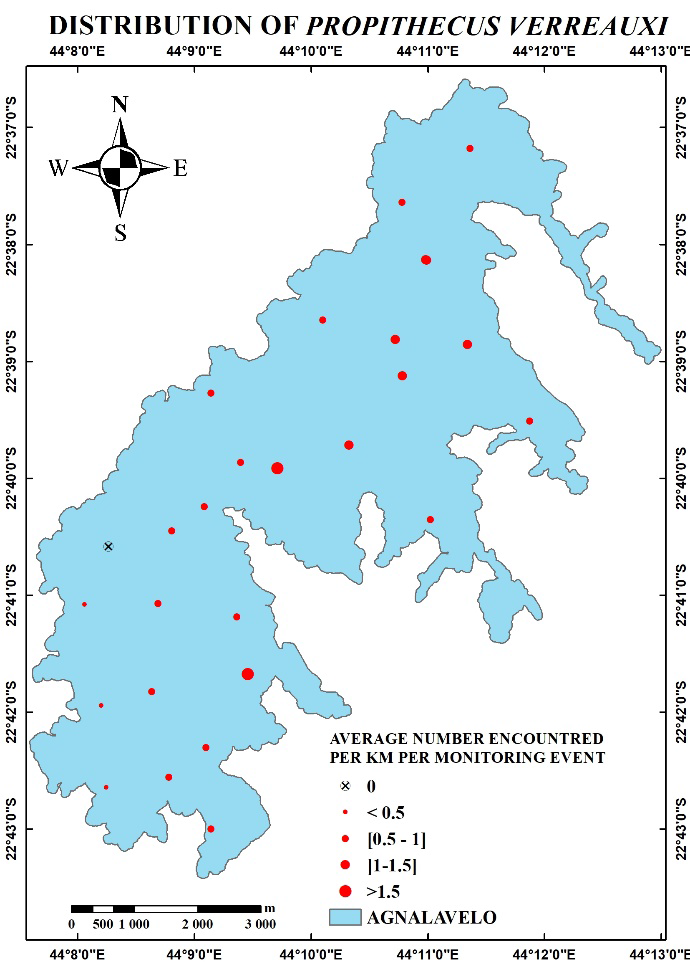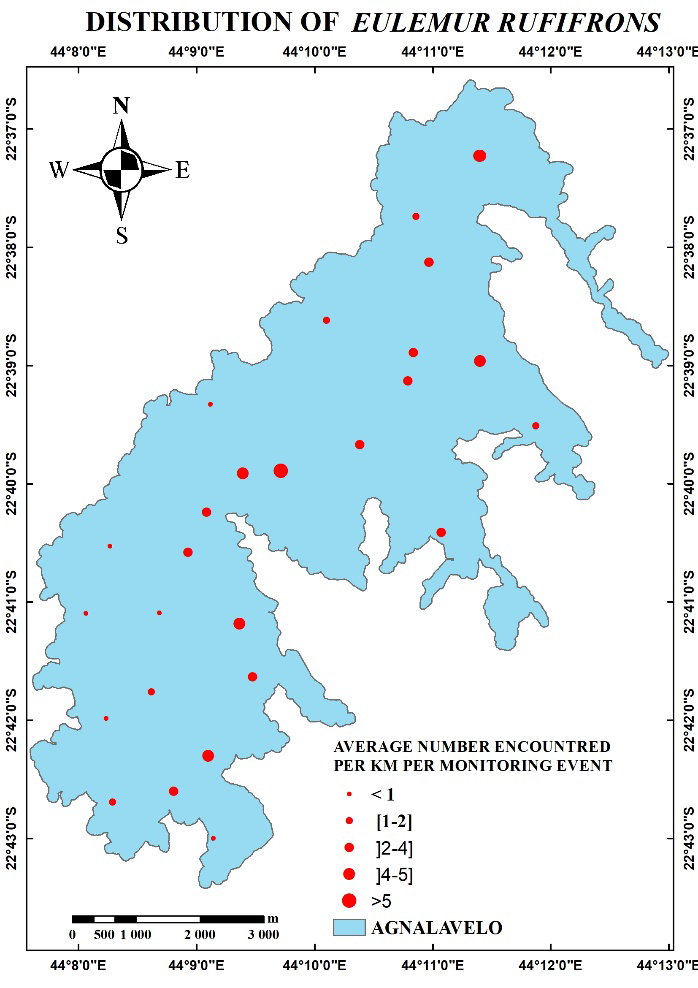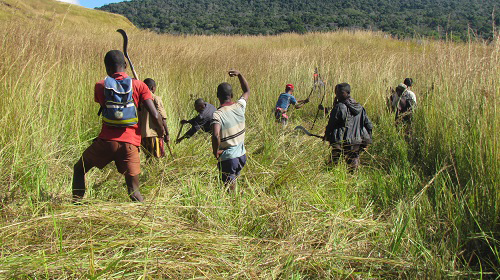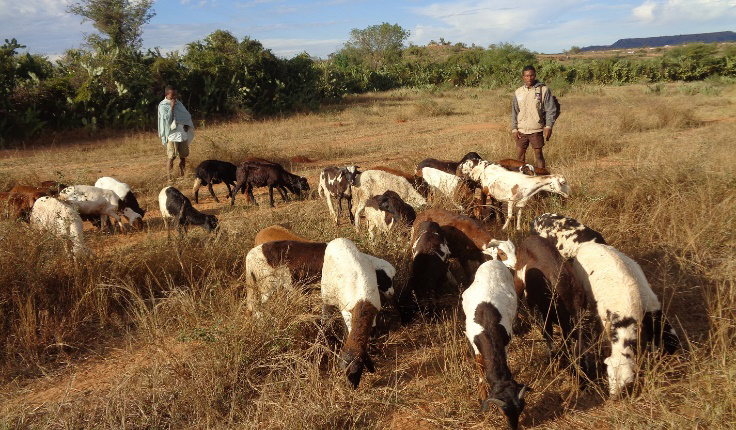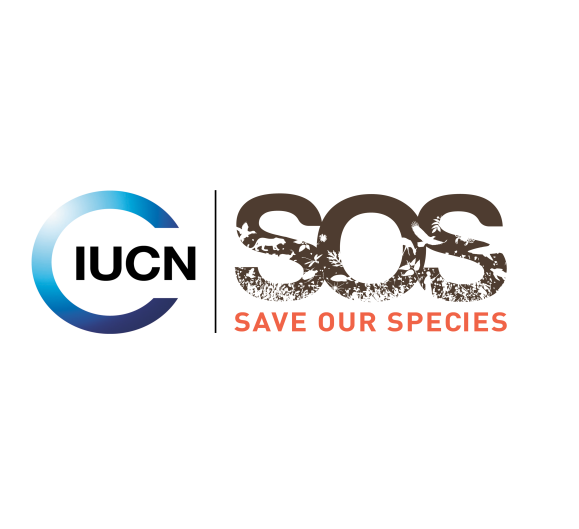STATUS OF THREE THREATENED LEMUR SPECIES AT THE ANALAVELONA SCARED FOREST, SOUTH- WESTERN MADAGASCAR
JAONASY MAËL FRANGIÇO & CHRIS BIRKINSHAW
January 2021
The Analavelona Forest (4487 ha), Sakaraha is a very rare example of evergreen western forest (Moat and Smith, 2007). This sub-humid vegetation exists here in the sub-arid SW of Madagascar due to the forest’s location on a modest massif that has an orographic effect causing a significant but very localized increase in precipitation. In addition to Analavelona’s diverse flora that includes several threatened and locally endemic species, the site provides habitat to an important albeit still poorly known fauna including 7 lemur species (Goodman et al. 2018).
Perhaps because this sub-humid forest is so remarkable within an otherwise sub-arid landscape, the local Bara people believe that it shelters the spirits of their ancestors and thus, under the influence of local kings called Lonaky, it has been respected and entered the 20 C. in almost pristine condition. However, now, the outside world has begun to under-mine the Lonaky’s influence as evidenced by a few, previously inconceivable incidents of timber exploitation occurring within the forest. Of more immediate concern, however, is the loss of forest due to wildfires. The Analavelona Forest is located in a landscape dominated vast lush grasslands. Towards the end of the dry season these grasslands often burn and, when stoked by strong winds, the fires can penetrate into the forest.
Missouri Botanical Garden’s Madagascar Program has been supporting community based conservation at the Analavelona Forest since 2009. From 2009 to 2015, MBG staff worked to complete the necessary research, complete consultations with local stakeholders, and compile the dossier requesting the designation of the site as a New Protected Area. The dossier was accepted by the diverse stakeholders and the site was designated as a new protected area, by government decree, in May 2015.
While MBG has a good knowledge of Analavelona’s remarkable flora of this site, our understanding of the fauna is much less complete, yet as co-managers of this site we are responsible for the conservation of resident animals as well as plants. Hence between April 2018 to November 2020 we were pleased to be able to complete a detailed study of the status at Analavelona of three diurnal lemur species: Propithecus verreauxi (Verreaux’s Sifaka, Fig. 1.) classified as Critically Endangered (A2cde+3cde+4cde) (Louis et al 2020), Lemur catta (Ring-tailed Lemur, Fig. 2) classified as Endangered (A4cd) (LaFleur and Gould 2020) and Eulemur rufifrons (Red-fronted Brown Lemur, Fig. 3) classified as Vulnerable (A2bcd+3bcd+4bcd) (Johnson et al 2020).
Our approach to providing this information was to recruit two local people (Ruffin and Tsimeloke) who we trained in lemur identification and ecology and the study protocols. The team marked out 26 transects totalling 46.095 km in all different sectors of the forest so as to represent the forest as a whole. Each transect was measured and mapped using a GPS Unit (Fig. 4). Then, each month from July 2019 to August 2020, the team slowly walked each transect and counted the lemurs of each species that they encountered. By also recording the perpendicular distance of the lemurs from the transect, it was possible to estimate the density of each lemur species in the forest, then, from the area of the forest, their abundance was estimated. In total, the teams walked the equivalent of 983.491 km during the study.
Both P. verreauxi and E. rufifrons were seen quite regularly during the transect walks but L. catta was never recorded. Analysis of the data collected for the former two species reveals their density within the protected area to be 14 individuals/km² and 49 individuals/km² respectively. Elsewhere density estimates for P. verreauxi include 41 individuals/km² in Kirindy Mitea National Park, 150–200/km² at Berenty, and 400–500/km² at Antserananomby (Mittermeier et al. 2010); whereas for E. rufifrons estimates include: 6.75 individuals/km² at Ranomafana National Park (Wright et al. 2012); 1.95-4.90 individuals/km² at Andringitra National Park (Rajaonson et al. 2014); 23.9/km² at Antseranomby (Kelley et al. 2007) and 20-30 individuals/km² at Kirindy Mitea (Mittermeier et al. 2010. From the estimates of density and the area of the Analavelona Forest the abundance of P. verreauxi and Eulemur rufifrons within the Analavelona Forest can be estimated as 628 and 2199 individuals respectively. Given that as a rule of thumb, conservation biologists consider that animal populations with less than 500 individuals may be a risk of inbreeding, the relatively small population of P. verreauxi is a matter of concern. It is very possible that there is movement of animals to and from the Analavelona Forest and other forest fragments in the neighbouring landscape and clearly, MBG, as co-managers of this site, need to consider methods of maintaining and facilitating this movement in the future such as reinforcing forest corridors. Such movement would promote out-breeding.
While we never encountered individuals of L. catta during the transect walks we did see this species within the Analavelona on a few occasions in the western part of the forest while walking to and from camp. It would thus seem that this lemur either very rare within this forest or perhaps only occasionally present – moving into the forest
from elsewhere at certain times of the year. Thus, both the importance of Analavelona Forest for this species and indeed the status of Lemur catta within the forest remain uncertain. Funding permitting, we hope to investigate this matter further.
Figures 5 and 6 show the distribution of P. verreauxi and E. rufifrons within the Analavelona Forest. While species occur throughout the forest there seems to be a general tendency for greater abundance in the eastern part of the forest compared the western part. This may be explained by the closer proximity of the western part of the forest to villages and certainly a few cases of lemur hunting were encountered during the study. Alternatively, the vegetation to the west has a distinctly drier aspect compared to that in the east. While the scale of the impact of hunting on these lemur populations remains uncertain it would seem wise to continue our investment in reducing this activity by supporting community patrols, raising local awareness of the importance of lemurs, and working with the Lonaky to promote the notion that the consumption of lemurs of lemur is not acceptable while providing alternative sources of meat from lemurs.
While, as nature lovers, it is natural to be horrified that threatened lemurs are being hunted and eaten, it should be understood that the people living around the Analavelona Forest have precarious lives that annually include periods of food poverty. Hence efforts to reduce lemur hunting must be accompanied by support to enable these people to access alternative sources of protein. Therefore, to accompany the research part of this project, we also supported an initiative to provide local people with 229 sheep. These animals were earned as compensation for those who helped install 23.6 km of fire-breaks around the forest. Thereby creating a win-win scenario where lemurs were protected by providing an alternative source of protein and the forest was better protected from penetration by wild fires.
References
Goodman, S.M., Raherilalao, M-J., Wohlhauser, S. 2018. The terrestrial protected areas of Madagascar: their history, description and biota. Association Vahatra, Antananarivo
Johnson, S., Narváez-Torres, P.R., Holmes, S.M., Wyman, T.M., Louis, E.E. & Wright, P. 2020. Eulemur rufifrons. The IUCN Red List of Threatened Species 2020: e.T136269A115581600. https://dx.doi.org/10.2305/IUCN.UK.2020-2.RLTS.T136269A115581600.en. Downloaded on 22 January 2021.
Kelley, E.A., Sussman, R. W. and Muldoon, K.M. 2007. The status of lemur species at Antserananomby: an update. Primate Conservation 22: 71-77.
LaFleur, M. and Gould, L. 2020. Lemur catta. The IUCN Red List of Threatened Species 2020: e.T11496A115565760. https://dx.doi.org/10.2305/IUCN.UK.2020-2.RLTS.T11496A115565760.en. Downloaded on 22 January 2021.
Louis, E.E., Sefczek, T.M., Bailey, C.A., Raharivololona, B., Lewis, R. and Rakotomalala, E.J. 2020. Propithecus verreauxi. The IUCN Red List of Threatened Species 2020: e.T18354A115572044. https://dx.doi.org/10.2305/IUCN.UK.2020-2.RLTS.T18354A115572044.en. Downloaded on 22 January 2021.
Mittermeier, R.A., Louis Jr., E.E., Richardson, M., Schwitzer, C., Langrand, O., Rylands, A.B., Hawkins, F., Rajaobelina, S., Ratsimbazafy, J., Rasoloarison, R., Roos, C., Kappeler, P.M. and MacKinnon, J. 2010. Lemurs of Madagascar. 3rd edition. Conservation International, Arlington, VA.
Moat, J. and Smith, P. 2007. Atlas of the vegetation of Madagascar. Kew, Kew Publishing, Royal Botanic Gardens, Kew.
Rajaonson, A., Jules, S. G., Ravelonjanahary, S. and Ratsimbazafy, J. 2014. Effet du microclimat et de la disponibilité alimentaire sur la répartition de Eulemur rufifrons dans la forêt humide du Parc National Andringitra. Lemur News 18: 30-33.
Wright, P.C., Erhart, E.M., Tecot, S.R., Baden, A.L., Arrigo-Nelson, S., Morelli, T.L., Deppe, A., Blanco, M., Atsalis, S., Johnson, S.E., Ratelolahy, F., Tan, C. L. M., Zohdy, S., King, S.J. 2012. Long-term lemur research at Centre ValBio, Ranomafana National Park, Madagascar. In: P.M. Kappeler and D.P. Watts (eds), Long-Term Field Studies of Primates, Springer-Verlag Berlin Heidelberg, Berlin.




